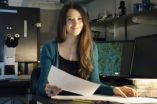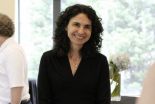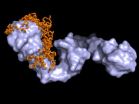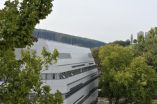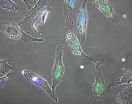(Press-News.org) In the race for better treatments and possible cures, rare diseases are often left behind. In a collaboration of researchers at The Rockefeller University, Memorial Sloan Kettering Cancer Center and the New York Genome Center (NYGC), an unusual mutation has been found that is strongly linked to one such disease: a rare liver cancer that affects teens and young adults. The results, published this week in Science, suggest that the mutation plays a key role in the development of the disease, called fibrolamellar hepatocellular carcinoma, and may also underlie more common cancers as well.
With only about 200 people diagnosed each year with fibrolamellar, the disease is as rare as it is mysterious — there are no known causes and it's difficult to both detect and treat. By the time doctors discover a growing tumor it is often too late, and the cancer has spread.
"We reasoned that it would be easier to identify genetic mutations in the tumors of young patients than in older ones, because in older people, the genome has been altered by years of aging and environmental factors," says Elana Simon, a co-first author on the study and a member of the Rockefeller team. "Both the person as a whole and the tumor itself will have had less time to accumulate mutations, so those that we do find are more likely to be relevant."
The researchers sequenced DNA and RNA at NYGC from tumors that had been surgically removed from 15 people with fibrolamellar. NYGC computational biologists and members of the Simon Laboratory at The Rockefeller University discussed the possibility of using a series of computer algorithms to search for sequence differences between the tumor samples and samples of healthy liver tissue. One abnormality that really stood out, and it was present in all 15 patients: a piece of DNA that had been broken and rejoined, creating a mutated gene that had the potential to wreak havoc in the bodies of individuals with the gene.
"We discovered chimeric RNAs in the tumor samples — made when DNA deletions create unnatural products that can drive cancer," says Nicolas Robine, co-first author and NYGC Computational Biologist. "This chimera had never been seen before, so we believe it will help drive the work of our Rockefeller colleagues and Elana's future. It is the NYGC's mission to undertake such collaborative genomic studies that will accelerate medical advances."
"Because of the deletion and then rejoining of the DNA, a new gene that was a mixture of two previous genes was created, called a chimera," says Elana Simon. "A number of other types of tumors have been shown to be driven by chimeras, but this one is unique — it codes for a kinase, an enzyme that modifies other proteins, that has not been identified in cancers." Furthermore, the researchers found that the kinase was made only in the tumor cells, and that it was constantly active. They believe that overproduction of this kinase may explain the uncontrolled growth of the tumor.
"These results were extremely encouraging," says Sanford Simon, the study's senior author and head of Rockefeller's Laboratory of Cellular Biophysics. "It is uncommon for a genetic screen for a cancer to turn up such a strong candidate mutation, and for the mutation to be present in every single patient tested."
For Elana Simon, who is finishing her senior year in high school and did the work after school and during breaks, the results are not only a scientific success, but also a profoundly personal one: her interest in studying the disease developed after she herself was diagnosed with fibrolamellar six years ago. The study was conducted in collaboration with the surgeon who removed her tumor in 2008, Michael P. LaQuaglia, Chief of the Pediatric Surgical Service at Memorial Sloan Kettering Cancer Center, and her father, Sanford Simon, as well as the NYGC team.
The research is also unusual in that it was funded not by a federal grant, but largely with private gifts from the Fibrolamellar Cancer Foundation and several individual donors whose lives have been touched by the disease. Additional support was also provided by the Howard Hughes Medical Institute, the New York Genome Center, The Rockefeller University Center for Clinical and Translational Science and by a gift to The Rockefeller University by an anonymous donor.
The Simon lab is now working on testing the effects of the chimera on human liver cells and in mouse livers, to further elucidate its role in the disease. If they can understand what's causing the tumors to develop, the scientists can work on not only treating them — using a genetic target to halt the cancer's growth — but also catching them before they even appear.
"The hope is that we'd be able to screen the blood for the presence of this chimera, and patients wouldn't have to wait until the tumors are present, until it might be too late, to do something about it," says Sanford Simon.
The work may also have implications for other cancers. "Genomics is allowing us to classify cancers based not on the organ they originate in, but on the molecular changes they trigger," says Sanford Simon. "Now that we know about this new chimera kinase, we can look for it in other cancers and work to develop new tools that will someday radically improve our ability to fight disease."
"NYGC is thrilled to have this work be our first published example of the explosive power of collaborations between deeply invested biologists like those in the Simon lab including Elana Simon, and thoughtful bioinformatics scientists like Nicolas Robine and NYGC team, who worked together so effectively with the tools of genomic sequencing and analysis to discover this new chimeric protein and cancer target," says Robert Darnell, head of Rockefeller's Laboratory of Molecular Neuro-Oncology, HHMI Investigator, and President and Scientific Director of NYGC. "The work done serves as an exemplar for how the power of interdisciplinary and inter-institutional genomic science has the potential to save people's lives in New York and beyond."
INFORMATION:
About The Rockefeller University
Founded by John D. Rockefeller in 1901, The Rockefeller University was this nation's first biomedical research institution. Hallmarks of the university include a research environment that provides scientists with the support they need to do imaginative science and a truly international graduate program that is unmatched for the freedom and resources it provides students to develop their capacities for innovative research. The Rockefeller University Hospital, founded in 1910 as the first center for clinical research in the United States, remains a place where researchers combine laboratory investigations with bedside observations to provide a scientific basis for disease detection, prevention and treatment. Since the institution's founding, Rockefeller University has been the site of many important scientific breakthroughs. Rockefeller scientists, for example, established that DNA is the chemical basis of heredity, identified the weight-regulating hormone leptin, discovered blood groups, showed that viruses can cause cancer, founded the modern field of cell biology, worked out the structure of antibodies, devised the AIDS "cocktail" drug therapy, and developed methadone maintenance for people addicted to heroin. Throughout Rockefeller's history, 24 scientists associated with the university have received the Nobel Prize in physiology/medicine and chemistry, and 21 scientists associated with the university have been honored with the Albert Lasker Medical Research Award. Five Rockefeller University scientists have been named MacArthur Foundation Fellows, and 20 have garnered the National Medal of Science. Currently, the university's award-winning faculty includes five Nobel laureates, seven Lasker Award winners and three recipients of the National Medal of Science. Thirty-four of the faculty are elected members of the National Academy of Sciences. For more information, go to http://www.rockefeller.edu.
About the New York Genome Center
The New York Genome Center (NYGC) is an independent, nonprofit at the forefront of transforming biomedical research and clinical care with the mission of saving lives. As a consortium of renowned academic, medical and industry leaders across the globe, NYGC focuses on translating genomic research into clinical solutions for serious disease. Our member organizations and partners are united in this unprecedented collaboration of technology, science, and medicine. We harness the power of innovation and discoveries to improve people's lives - ethically, equitably, and urgently. Member institutions include: Albert Einstein College of Medicine, American Museum of Natural History, Cold Spring Harbor Laboratory, Columbia University, Cornell University/Weill Cornell Medical College, Hospital for Special Surgery, The Jackson Laboratory, Memorial Sloan-Kettering Cancer Center, Icahn School of Medicine at Mount Sinai, New York-Presbyterian Hospital, The New York Stem Cell Foundation, New York University, North Shore-LIJ, The Rockefeller University, Roswell Park Cancer Institute and Stony Brook University. For more information, visit: http://www.nygenome.org.
Researchers discover unusual genetic mutation linked to adolescent liver cancer
2014-02-28
ELSE PRESS RELEASES FROM THIS DATE:
Retention leads to discipline problems in other kids
2014-02-28
DURHAM, N.C -- When students repeat a grade, it can spell trouble for their classmates, according to a new Duke University-led study of nearly 80,000 middle-schoolers.
In schools with high numbers of grade repeaters , suspensions were more likely to occur across the school community. Discipline problems were also more common among other students, including substance abuse, fighting and classroom disruption.
Public debate typically focuses on how retention affects an individual student's academic performance, said lead author Clara Muschkin. So she and her colleagues ...
Dangerous mistaken identity
2014-02-28
This news release is available in German.
Proteins like the so-called heat shock protein Hsp90 play an important role in almost all processes within human cells. They help other proteins fold into their three-dimensional structure or return damaged proteins back into their proper shape.
Recently, there has been increasing evidence indicating that the heat shock protein HSP90 may also be involved in the folding processes of the tau protein. Deposits of tau proteins in brain cells are typical for Alzheimer's disease and are held responsible for decaying nerve ...
Diabetes and obesity more common in socioeconomically deprived regions
2014-02-28
Living in a socioeconomically deprived region is a risk factor for being affected by diabetes mellitus and obesity. This holds true regardless of the individual social status of the inhabitants. This is the conclusion reached by scientists from the Institute of Health Economics and Health Care Management (IGM) at the Helmholtz Zentrum München (HMGU) and the Department of Epidemiology and Health Monitoring at the Robert Koch Institute (RKI) in Berlin. "Regional factors, such as the population's average income, unemployment or quality of the living environment can affect ...
Unearthing key function of plant hormone
2014-02-28
This news release is available in German.
Plants, like animals, employ hormones as messengers, which coordinate growth and regulate how they react to the environment. One of these plant hormones, auxin, regulates nearly all aspects of plant behavior and development, for example phototropism, root growth and fruit growth. Depending on the context, auxin elicits a range of responses such as cell polarization or division. In this week's edition of Science (DOI:10.1126/science.1245125), a team of researchers including Jiri Friml from IST Austria and led by Zhenbiao ...
Scientists discover the specific types of macrophages that affect Crohn's disease severity
2014-02-28
For those coping with Crohn's disease, a new research report published in the Journal of Leukocyte Biology offers hope for the development of new and more effective drugs. In the report, scientists show for the first time, precisely what type of immune cells are involved in driving the inflammation process in the disease. With this knowledge, new compounds can be identified which reduce the activity of these cells or lessen their inflammatory effects.
"By increasing the knowledge on the different macrophage subsets in the intestine and their blood counterparts, we hope ...
York physicists pave the way for more energy efficient technology
2014-02-28
An international team of scientists led by physicists from the University of York has paved the way for a new class of magnetic materials and devices with improved performance and power efficiency.
Magnetic materials are currently used to store almost all digital information. However, with information processing and storage now making up a significant fraction of the world's energy consumption, continuing improvements in energy efficiency will require new technologies and materials.
A promising development is all-optical thermally induced magnetic switching (TIMS), which ...
Emergency alert in the cell
2014-02-28
When an organism is exposed to life-threatening conditions, it sounds the alarm and a cellular emergency program, the heat shock response, is initiated. However, the name "heat shock response" is misleading. In the beginning of the 1960s, this form of stress response was first observed. Scientists exposed fruit flies to high temperatures and discovered a complex emergency program designated to save single cells and thus the organism itself. Today researchers know that this program is also triggered by other dangers such as radiation or toxic substances. The terminology, ...
Twitter 'big data' can be used to monitor HIV and drug-related behavior, UCLA study shows
2014-02-28
Real-time social media like Twitter could be used to track HIV incidence and drug-related behaviors with the aim of detecting and potentially preventing outbreaks, a new UCLA-led study shows.
The study, published in the peer-reviewed journal Preventive Medicine, suggests it may be possible to predict sexual risk and drug use behaviors by monitoring tweets, mapping where those messages come from and linking them with data on the geographical distribution of HIV cases. The use of various drugs had been associated in previous studies with HIV sexual risk behaviors and ...
Competition breeds new fish species, study finds
2014-02-28
Competition may play an important role during the evolution of new species, but empirical evidence for this is scarce, despite being implicit in Charles Darwin's work and support from theoretical studies.
Dr Martin Genner from Bristol's School of Biological Sciences and colleagues used population genetics and experimental evidence to demonstrate a role for competition that leads to the differentiation of new species within the highly diverse cichlid fishes of Lake Tanganyika in East Africa.
They found that the cichlid fish Telmatochromis temporalis shows two genetically ...
Rise in New York foreclosures means many could benefit from bankruptcy
2014-02-28
Rise in New York foreclosures means many could benefit from bankruptcy
Article provided by Michael A. Fakhoury, Esq., P.C.
Visit us at http://www.fakhourylaw.com
According to a report from the chief administrator of courts in New York, the number of foreclosurefilings in 2013 exceeded the totals for 2012 and 2011 combined. In some areas, the problem has been particularly pronounced.
A report from the Times Herald-Record indicated that foreclosure filings approximately doubled in Orange and Ulster counties from 2012 to 2013. RealtyTrac, a company that tracks foreclosures, ...
